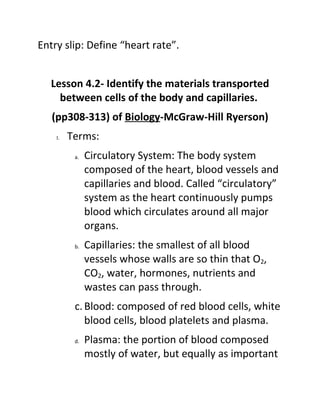
BIO30S 4 2 Id Materials Trans Bw Cells
- 1. Entry slip: Define “heart rate”. Lesson 4.2- Identify the materials transported between cells of the body and capillaries. (pp308-313) of Biology-McGraw-Hill Ryerson) I. Terms: a. Circulatory System: The body system composed of the heart, blood vessels and capillaries and blood. Called “circulatory” system as the heart continuously pumps blood which circulates around all major organs. b. Capillaries: the smallest of all blood vessels whose walls are so thin that O2, CO2, water, hormones, nutrients and wastes can pass through. c. Blood: composed of red blood cells, white blood cells, blood platelets and plasma. d. Plasma: the portion of blood composed mostly of water, but equally as important
- 2. is composed of a small amount of O2, CO2, hormones, nutrients and wastes. e. Diffusion: The movement of molecules from an area of high concentration to an area of low concentration. Remember: the sugar cube in beaker of water demo and the onion/salt demo. II. Circulatory System as a mode of Transportation: a. “Picking up”- Capillaries that pass by the body’s cells will pick up small particles by diffusion. b. “Dropping off”-Capillaries that pass by the body’s cells will drop off small particles by diffusion. III.Materials transported between the cells of the body and the capillaries: a. CO2- Created as a by-product of energy production in each cell. i. Picked up at every cell.
- 3. ii. Must be transported to lungs for exhalation. b. O2- Needed at every cell for energy production in the cell. i. Picked up at the lungs (See Unit 2- Respiration) ii. Dropped off at every cell in the body. Remember, this movement of O2 from the blood across to the cell is called “internal respiration”. c. Hormones- Chemicals created in special glands in the body that give instructions to specific cells and organs in other parts of the body to perform certain tasks. (ex: adrenaline produced by adrenal glands in kidneys instructs blood vessels to constrict, thus increasing blood pressure). i. Picked up at various glands in the body. ii. Must be transported to the target cells and organs.
- 4. d.Nutrients- CHO’s, protein, lipids, vitamins, minerals and water. See Unit 1-Digestion and Nutrition for information on their functions. i. Picked up in digestive tract after being eaten and digested. Also picked up from areas that they are stored or filtered in the body, such as: A. the liver (glycogen and vitamins) B. fat cells: (lipids) C. nephrons in kidney (reabsorption and filtration) ii. Must be transported to all areas of the body where the nutrients are needed. e. Nitrogenous wastes- Three of the four primary metabolic wastes (urea, uric acid and creatinine). See Unit 3-Excretion and Waste Management for more details. i. Picked up: A.In liver (urea)
- 5. B. From dead cells all over the body (uric acid) C. In muscles (creatinine) ii. Must be transported to kidneys to be filtered out of the blood plasma and excreted by urination. IV. Homework Assignment: a.Complete the cross-word puzzle handout. b. Due next class.